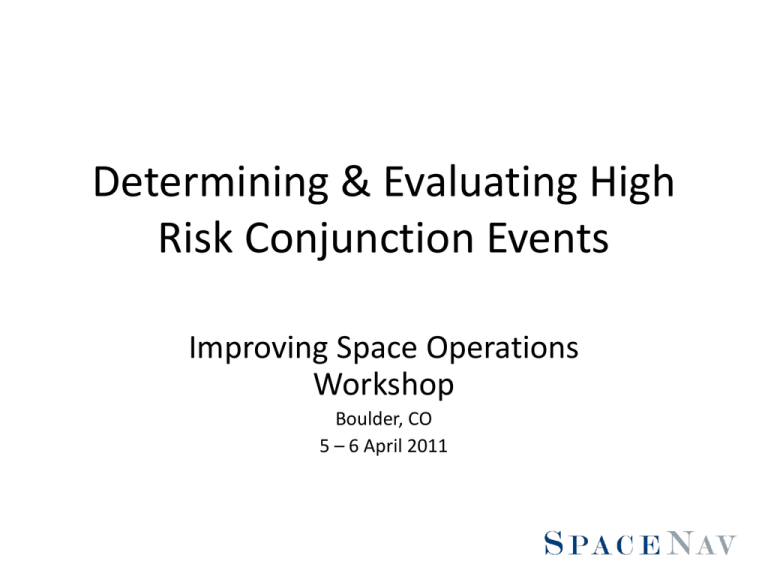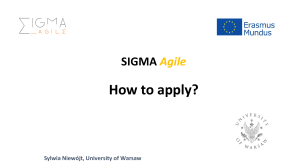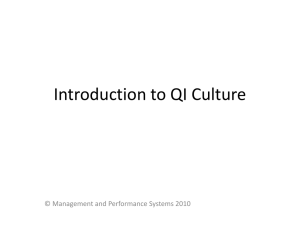Collision Probability
advertisement

Determining & Evaluating High Risk Conjunction Events Improving Space Operations Workshop Boulder, CO 5 – 6 April 2011 Introduction • • • • • • • Conjunction Assessment Process Collision Probability Sigma Level Analysis Alignment of Radial Vectors Collision Probability Sensitivity Maximum Collision Probability High Risk Events Conjunction Assessment Process (1/2) • Conjunction assessment is performed based on state and state uncertainty data generated and disseminated by the JSpOC. • Close approach predictions are generated based on a 5-day screening span. • Results are sent out daily, or more frequently for high risk conjunction events. • Predictions are made using data from the JSpOC highaccuracy space object catalog. Conjunction Assessment Process (2/2) • The typical conjunction assessment process for a satellite program is to receive Orbital Conjunction Messages (OCMs) for secondary objects that are predicted to violate a designated screening volume around the primary satellite. • OCMs contain sufficient data to calculate a Pc value; i.e., state vector and state uncertainty data. • The screening volume must be large enough to capture close approaches with objects with a wide range of covariance sizes—this can result in large amounts of data and many conjunction events that are not a threat. Collision Probability (1/2) • Collision probability (Pc) is a measure of the overlap of the error distribution of the two objects, where the error distribution is given by the covariance matrix. • When the covariances of the objects are combined, Pc can be thought of as the relationship of the miss vector to the combined covariance. Primary & Secondary object with covariance ellipsoids Combined covariance with keep-out region positioned by miss vector Collision Probability (2/2) • Pc is used as the primary measure of risk since it captures the miss distance, the relative geometry, and the associated uncertainty of the close approach. • A conjunction assessment process based on miss distance alone does not account for the uncertainty inherent in the problem. • Miss distance is used as the basis of the screening process, leading to the receipt of many OCMs for conjunction events with zero Pc values. • This approach can lead to large amounts of data; especially for satellites in LEO. Sigma Level Analysis (1/2) • The miss vector and the state uncertainty of the two objects can be used for a streamlined screening process. • The sigma level can be calculated using the Radial, Intrack, and Crosstrack (RIC) directions of the primary. 𝑅𝑎𝑑𝑖𝑎𝑙 𝑠𝑖𝑔𝑚𝑎 𝑙𝑒𝑣𝑒𝑙 = 𝜌𝑅 𝜎𝑅𝑝 + 𝜎𝑅𝑠 𝐼𝑛 − 𝑝𝑙𝑎𝑛𝑒 𝑠𝑖𝑔𝑚𝑎 𝑙𝑒𝑣𝑒𝑙 = where 𝜌 ≡ 𝑚𝑖𝑠𝑠 𝑑𝑖𝑠𝑡𝑎𝑛𝑐𝑒 𝜌𝐼 2 + 𝜌𝐶 𝜎𝐼𝑝 + 𝜎𝐼𝑠 2 𝜌𝐼𝐶 = 𝜎𝐼𝑝 + 𝜎𝐼𝑠 and 𝜎 ≡ 𝑒𝑟𝑟𝑜𝑟 𝑠𝑡𝑎𝑛𝑑𝑎𝑟𝑑 𝑑𝑒𝑣𝑖𝑎𝑡𝑖𝑜𝑛 • OCMs are not required for these calculations. Sigma Level Analysis (2/2) • The two semi-major axes equal the largest possible in-plane uncertainty component, 𝜎𝐼𝑝 + 𝜎𝐼𝑠 ; and the semi-minor axis equals the sum of the radial uncertainties, 𝜎𝑅𝑝 + 𝜎𝑅𝑠 . • A high sigma level from either calculation should result in a near zero Pc value, but a low sigma level does not necessarily lead to a high Pc value. • A sigma level > 4 is recommended. 𝑅𝑝 𝜌𝑅 𝐶𝑝 𝜌𝐶 𝜌 𝐼𝑝 𝜌𝐶 𝜌𝐼𝐶 Sigma Level Analysis Results • Sample report of data required: Predicted Miss Distances Primary Error at TCA Secondary Error at TCA Total Radial Intrack Crosstrack Radial Intrack Crosstrack Radial Intrack Crosstrack 𝜌 𝜌𝑅 𝜌𝐼 𝜌𝐶 𝜎𝑅𝑝 𝜎𝐼𝑝 𝜎𝐶𝑝 𝜎𝑅𝑠 𝜎𝐼𝑠 𝜎𝐶𝑠 • Sample results with corresponding collision probability: Case Radial Sigma Level In-plane Sigma Level Collision Probability 1 2.29 0.35 7.78e-5 2 1.13 3.42 5.18e-9 3 -9.29 0.05 0 4 0.84 0.36 1.18e-3 5 4.17 0.09 4.74e-012 Alignment of Radial Vectors 𝜌𝐼𝐶 = 𝜌𝐼 2 + 𝜌𝐶 2 Since 𝑟𝑠 ≫ 𝜌𝐼𝐶 for tangible conjunction events, 𝜑 is small and the two Radial unit vectors can be considered collinear for the purposes of this analysis. 𝐼𝑝 𝜌𝐼𝐶 𝑟𝑠 𝑟𝑝 ≡ 𝑚𝑖𝑠𝑠 𝑑𝑖𝑠𝑡𝑎𝑛𝑐𝑒 𝑖𝑛 𝐼𝑛𝑡𝑟𝑎𝑐𝑘 & 𝐶𝑟𝑜𝑠𝑠𝑡𝑟𝑎𝑐𝑘 𝑓𝑟𝑎𝑚𝑒 𝑜𝑓 𝑝𝑟𝑖𝑚𝑎𝑟𝑦 𝜌𝐼𝐶 𝜑 = arc𝑠𝑖𝑛 𝑟𝑠 ≡ 𝑎𝑛𝑔𝑙𝑒 𝑏𝑒𝑡𝑤𝑒𝑒𝑛 𝑅𝑎𝑑𝑖𝑎𝑙 𝑢𝑛𝑖𝑡 𝑣𝑒𝑐𝑡𝑜𝑟𝑠 𝑅𝑠 𝐶𝑠 • The Radial unit vectors of the two 𝑅𝑝 objects nearly align for conjunction events, therefore, the Radial 𝐶𝑝 direction can be decoupled from the Intrack and Crosstrack directions. 𝜑 𝜑 Earth center 𝜌𝐼𝐶 𝜌𝑅 𝐼𝑠 Collision Probability Sensitivity log Pc • Covariance size can be scaled to determine the sensitivity of the Pc value. • Since covariance is propagated from OD epoch to Time of Close Approach (TCA), a Collision Probability Sensitivity -4 reduction in covariance size gives an indication of how -5 the Pc will evolve. -6 • This calculation is -7 performed with a static -8 miss distance. -9 -10 0.2 0.3 0.4 0.5 0.6 0.7 0.8 Normalized Covariance Size 0.9 1 Maximum Collision Probability Normalized Covariance Size 12 10 8 6 4 2 0 4 Sigma Level log Pc • The Pc sensitivity curve allows evaluation of the Pc max condition. • Pc max tends to occur when the miss vector lies on the 1-sigma uncertainty ellipsoid. Collision Probability Sensitivity -2 • Most conjunction events -3 evolve to the left of the -4 Pc max condition. Pc . -5 Radial Sigma Level • Those that don’t tend to -6 In-plane Sigma Level be of concern … -7 • Notice that in this example -8 the covariance was enlarged -9 to show Pc max. -10 0 0.5 1 1.5 2 2.5 3 3.5 log Pc • Some conjunction events show little change in Pc as the covariance is contracted. • This occurs when the miss vector is within the 1 or 2-sigma of the combined covariance Collision Probability Sensitivity -2.5 2.5 ellipsoid. 2 • This condition can be a sign Pc . Radial Sigma Level that the conjunction event -3 In-plane Sigma Level 1.5 will remain a threat as the TCA approaches. 1 -3.5 0.5 -4 0.2 0.3 0.4 0.5 0.6 0.7 0.8 Normalized Covariance Size 0.9 0 1 Sigma Level High Risk Events








